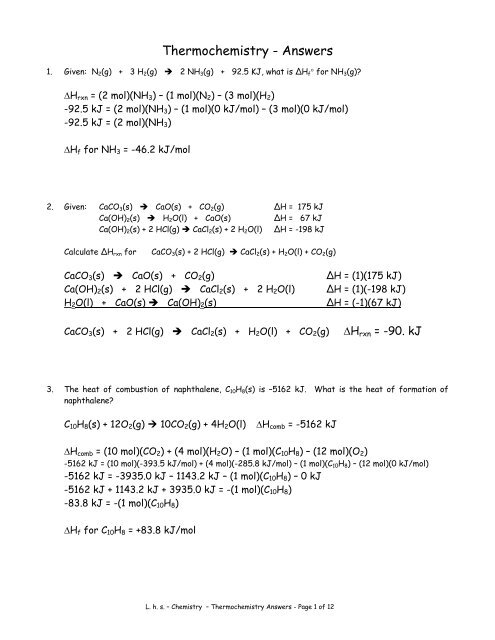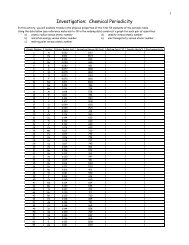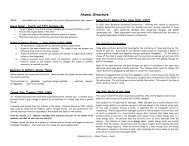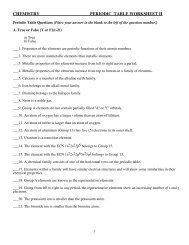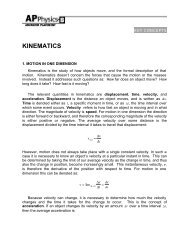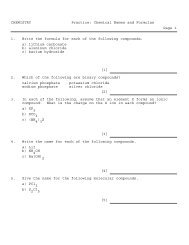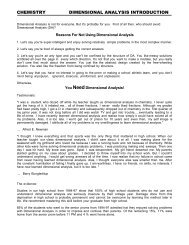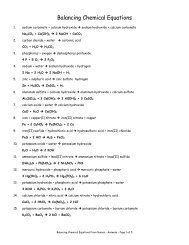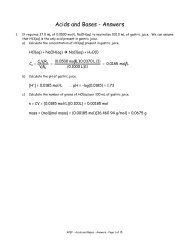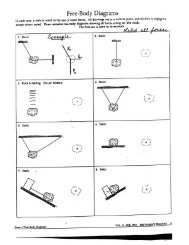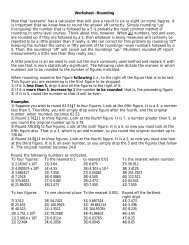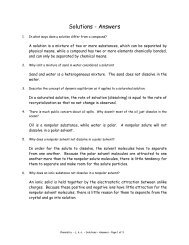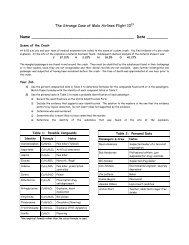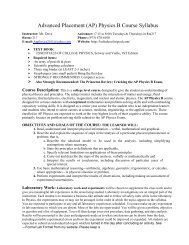Thermochemistry - Answers
Thermochemistry - Answers
Thermochemistry - Answers
- No tags were found...
You also want an ePaper? Increase the reach of your titles
YUMPU automatically turns print PDFs into web optimized ePapers that Google loves.
<strong>Thermochemistry</strong> - <strong>Answers</strong>1. Given: N 2 (g) + 3 H 2 (g) 2 NH 3 (g) + 92.5 KJ, what is ∆H f ° for NH 3 (g)?∆H rxn = (2 mol)(NH 3 ) – (1 mol)(N 2 ) – (3 mol)(H 2 )-92.5 kJ = (2 mol)(NH 3 ) – (1 mol)(0 kJ/mol) – (3 mol)(0 kJ/mol)-92.5 kJ = (2 mol)(NH 3 )∆H f for NH 3 = -46.2 kJ/mol2. Given: CaCO 3 (s) CaO(s) + CO 2 (g) ∆H = 175 kJCa(OH) 2 (s) H 2 O(l) + CaO(s)∆H = 67 kJCa(OH) 2 (s) + 2 HCl(g) CaCl 2 (s) + 2 H 2 O(l) ∆H = -198 kJCalculate ∆H rxn forCaCO 3 (s) + 2 HCl(g) CaCl 2 (s) + H 2 O(l) + CO 2 (g)CaCO 3 (s) CaO(s) + CO 2 (g)Ca(OH) 2 (s) + 2 HCl(g) CaCl 2 (s) + 2 H 2 O(l)H 2 O(l) + CaO(s) Ca(OH) 2 (s)∆H = (1)(175 kJ)∆H = (1)(-198 kJ)∆H = (-1)(67 kJ)CaCO 3 (s) + 2 HCl(g) CaCl 2 (s) + H 2 O(l) + CO 2 (g)∆H rxn = -90. kJ3. The heat of combustion of naphthalene, C 10 H 8 (s) is –5162 kJ. What is the heat of formation ofnaphthalene?C 10 H 8 (s) + 12O 2 (g) 10CO 2 (g) + 4H 2 O(l)∆H comb = -5162 kJ∆H comb = (10 mol)(CO 2 ) + (4 mol)(H 2 O) – (1 mol)(C 10 H 8 ) – (12 mol)(O 2 )-5162 kJ = (10 mol)(-393.5 kJ/mol) + (4 mol)(-285.8 kJ/mol) – (1 mol)(C 10 H 8 ) – (12 mol)(0 kJ/mol)-5162 kJ = -3935.0 kJ – 1143.2 kJ – (1 mol)(C 10 H 8 ) – 0 kJ-5162 kJ + 1143.2 kJ + 3935.0 kJ = -(1 mol)(C 10 H 8 )-83.8 kJ = -(1 mol)(C 10 H 8 )∆H f for C 10 H 8 = +83.8 kJ/molL. h. s. – Chemistry – <strong>Thermochemistry</strong> <strong>Answers</strong> - Page 1 of 12
4. Calculate the amount of heat given off when 100.0 g of C 7 H 8 (l) burns. The: ∆H f = 50.0 kJ/mol forC 7 H 8 (l),C 7 H 8 (l) + 9O 2 (g) 7CO 2 (g) + 4H 2 O(l)∆H comb = (7 mol)(CO 2 ) + (4 mol)(H 2 O) – (1 mol)(C 7 H 8 ) – (9 mol)(O 2 )∆H comb = (7 mol)(-393.5 kJ/mol) + (4 mol)(-285.8 kJ/mol) – (1 mol)(50.0 kJ/mol) – (9 mol)(0 kJ/mol)∆H comb = -2754.5 kJ – 1143.2 kJ – 50.0 kJ∆H comb = -3947.7 kJmol =100.0 g92.14052 gmol= 1.085 mol1 mol1.085 mol=− 3947.7 kJxx = − 4280 kJ for 100.0 g of C H 7 85. The standard enthalpy of combustion of C 2 H 2 (g) is –1301 kJ/mol. What is the standard enthalpy offormation for C 2 H 2 (g)?2C 2 H 2 (g) + 5O 2 (g) 4CO 2 (g) + 2H 2 O(l)∆H comb = (4 mol)(CO 2 ) + (2 mol)(H 2 O) – (2 mol)(C 2 H 2 ) – (5 mol)(O 2 )-2602 kJ = (4 mol)(-393.5 kJ/mol) + (2 mol)(-285.8 kJ/mol) – (2 mol)(C 2 H 2 ) – (5 mol)(0 kJ/mol)-2602 kJ = -1574.0 kJ – 571.6 kJ - (2 mol)(C 2 H 2 ) – 0 kJ-456.4 kJ = - (2 mol)(C 2 H 2 )∆H f C 2 H 2 = +228 kJ/molL. h. s. – Chemistry – <strong>Thermochemistry</strong> <strong>Answers</strong> - Page 2 of 12
6. How much heat will be required to make 1.00 kg of CaC 2 (s) according to the reaction given below?The ∆H f value for CaC 2 (s) is –63 kJ/mol.CaO(s) + 3 C(s) CaC 2 (s) + CO(g)∆H rxn = (1 mol)(CaC 2 ) + (1 mol)(CO) – (1 mol)(CaO) – (3 mol)(C)∆H rxn = (1 mol)(-63 kJ/mol) + (1 mol)(-110.5 kJ/mol) – (1 mol)(-635.1 kJ/mol) – (3 mol)(0 kJ/mol)∆H rxn = -63 kJ – 110.5 kJ + 631.5 kJ – 0 kJ∆H rxn = +461.6 kJ1000.0 gmol =64.100 g mol= 15.6 mol1 mol15.6 mol=461.6 kJxx = 7200 kJ for 1.00 kg of CaC 27. 150.0 mL of 0.200 mol/L HCl was added to 150.0 mL of 0.200 mol/L NaOH in a styrene cup. Initialtemperature of both solutions was 25.0˚C. The final temperature was 27.1˚C. Calculate the heat ofreaction per mole of hydrochloric acid.Heat released by the reaction = heat absorbed by calorimeter and water∆H = mc∆T (calorimeter) + mc∆T (water - HCl(aq)) + mc∆T (water - NaOH(aq))assume the heat absorbed by the coffee cup calorimeter is negligible∆H = mc∆T (water - HCl(aq)) + mc∆T (water - NaOH(aq))∆H = (150.0 g)(4.18 g/J°C)(2.1°C) + (150.0 g)(4.18 g/J°C)(2.1°C)∆H = 1316.7 J + 1316.7 J∆H = 2633.4 J absorbed by the calorimeter and water∆H = -2633.4 J for 50.0 mL of 1.00 mol/L HCln=CV = (0.200 mol/L)(0.1500 L) = 0.0300 mol HCl0.0300 mol1.00 mol=− 2.6334 kJxx = −88 kJmol=∆HrxnL. h. s. – Chemistry – <strong>Thermochemistry</strong> <strong>Answers</strong> - Page 3 of 12
13. Exactly 3.00 g of C(s) was burned to CO 2 (g) in a copper calorimeter. The mass of the calorimeterwas 1.500 kg and the mass of the water in which the calorimeter was immersed was 2.000 kg. Theinitial temperature of the system was 20.0°C and the final temperature was 31.0°C. Calculate theheat of formation of CO 2 (g), under the conditions present in the calorimeter.C(s) + O 2 (g) CO 2 (g)Heat released by the reaction = heat absorbed by calorimeter and water∆H = mc∆T (calorimeter) + mc∆T (water)∆H = (1.500 kg)(0.385 kg/kJ°C)(11.0°C) + (2.000 kg)(4.18 kJ/kg°C)(11.0°C)∆H = 6.33525 kJ + 92.048 kJ∆H = 98.41 kJ absorbed by calorimeter and water∴ 98.41 kJ were released by the combustion of 3.00 g of carbonmol = mass ÷ molar massmol = 3.00 g ÷ 12.011 g/mol = 0.2498 mol C= 0.2498 mol CO 2− 98.41 kJ 0.2498 mol CO=2x1 molx = -394 kJ/mol∆H f for CO 2 = -394 kJ/molL. h. s. – Chemistry – <strong>Thermochemistry</strong> <strong>Answers</strong> - Page 9 of 12
14. The specific heat capacity of Ni(s) is 0.444 kJ/Kg°C. A 3.85 g sample of benzoic acid, C 6 H 5 COOH(s),was burned in a nickel calorimeter having a mass of 0.850 kg and immersed in 1.200 kg of water. Theinitial temperature of the system was 23.0°C and the final temperature was 41.0°C. Calculate theheat of combustion of benzoic acid, under the conditions present inside the calorimeter.Heat released by the reaction = heat absorbed by calorimeter and water∆H = mc∆T (calorimeter) + mc∆T (water)∆H = (0.850 kg)(0.444 kg/kJ°C)(18.0°C) + (1.200 kg)(4.18 kJ/kg°C)(18.0°C)∆H = 6.7932 kJ + 90.288 kJ∆H = 97.0812 kJ absorbed by the calorimeter and water∆H = -97.0812 kJ for 3.85 g of benzoic acid3.85 gmol =122.12344 gmol= 0.0315 mol0.0315 mol1.00 mol=− 97.0812 kJxx = −3080 kJmol=∆Hcombfor benzoic acid15. A 2.50g sample of sucrose, C 12 H 22 O 11 (s) was burned in a 2.100 kg iron calorimeter immersed in 1.450kg of water. The initial temperature of the system was 24.32°C and the final temperature was30.20°C. Determine the heat of combustion of sucrose, under the conditions present inside thecalorimeter.Heat released by the reaction = heat absorbed by calorimeter and water∆H = mc∆T (calorimeter) + mc∆T (water)∆H = (2.100 kg)(0.444 kg/kJ°C)(5.88°C) + (1.450 kg)(4.18 kJ/kg°C)(5.88°C)∆H = 5.482512 kJ + 35.63868 kJ∆H = 41.12 kJ absorbed by the calorimeter and water∆H = -41.121 kJ for 2.50 g of sucrose2.50 gmol =342.30008 gmol= 0.00730 mol0.00730 mol1.00 mol=−41.12 kJxx = −5630 kJmol=∆Hcombfor sucroseL. h. s. – Chemistry – <strong>Thermochemistry</strong> <strong>Answers</strong> - Page 10 of 12
16. 50.0 mL of 0.800 mol/L hydrobromic acid was added to 50.0 mL of 0.800 mol/L potassium hydroxidein a styrene cup. Initial temperature of both solutions was 23.18˚C. Final temperature was 26.38˚C.Calculate the heat of reaction per mole of hydrobromic acid.Heat released by the reaction = heat absorbed by calorimeter and water∆H = mc∆T (calorimeter) + mc∆T (water - HBr(aq)) + mc∆T (water - KOH(aq))assume the heat absorbed by the coffee cup calorimeter is negligible∆H = mc∆T (water - HBr(aq)) + mc∆T (water - KOH(aq))∆H = (50.0 g)(4.18 g/J°C)(3.20°C) + (50.0 g)(4.18 g/J°C)(3.20°C)∆H = 668.8 J + 668.8 J∆H = 1337.6 J absorbed by the calorimeter and water∆H = -1337.6 J for 50.0 mL of 1.00 mol/L HCln=CV = (0.800 mol/L)(0.0500 L) = 0.0400 mol HCl0.0400 mol1.00 mol=− 1.3376 kJxx = −33.4 kJmol=∆HrxnL. h. s. – Chemistry – <strong>Thermochemistry</strong> <strong>Answers</strong> - Page 11 of 12
17. When 50.0mL of 1.00mol/L HCl(aq) and 50.0 mL of 1.00mol/L NaOH(aq) are mixed in a “coffee cup”calorimeter, the temperature of the resulting solution increases from 21.0°C to 27.5°C. Use thespecific heat capacity of H 2 O(l), given on page one of the Chemistry Data Booklet, to calculate theheat of this reaction measured in kilojoules per mole of HCl(aq).HCl(aq) + NaOH(aq) NaCl(aq) + H 2 O(l)Heat released by the reaction = heat absorbed by calorimeter and water∆H = mc∆T (calorimeter) + mc∆T (water - HCl(aq)) + mc∆T (water - NaOH(aq))assume the heat absorbed by the coffee cup calorimeter is negligible∆H = mc∆T (water - HCl(aq)) + mc∆T (water - NaOH(aq))∆H = (50.0 g)(4.18 g/J°C)(6.5°C) + (50.0 g)(4.18 g/J°C)(6.5°C)∆H = 1358.5 J + 1358.5 J∆H = 2717 J absorbed by the calorimeter and water∆H = -2717 J for 50.0 mL of 1.00 mol/L HCln=CV = (1.00 mol/L)(0.0500 L) = 0.0500 mol HCl0.0500 mol1.00 mol=− 2.717 kJxx = −54.3 kJmol=∆Hrxn18. We often have to make assumptions when we conduct laboratory experiments. Consider carefully theexperiment described in question 17, and list four unstated assumptions that must be made in orderfor one to determine the heat of reaction.1. We assume that the reaction happens fast enough that no heat is transferredfrom the system to the environment or vice versa.2. We assume that the densities of HCl(aq), NaOH(aq), and NaCl(aq) all equal 1.00g/mol.3. We assume that it does take 4.184 J to increase the temperature of the solutionby 1.00ºC just as it does for pure water.4. We assume that we can ignore the heat capacity of the material from which thecoffee cup” is made and that the total heat capacity of the calorimeter is justthe heat capacity of the liquid contents.L. h. s. – Chemistry – <strong>Thermochemistry</strong> <strong>Answers</strong> - Page 12 of 12


